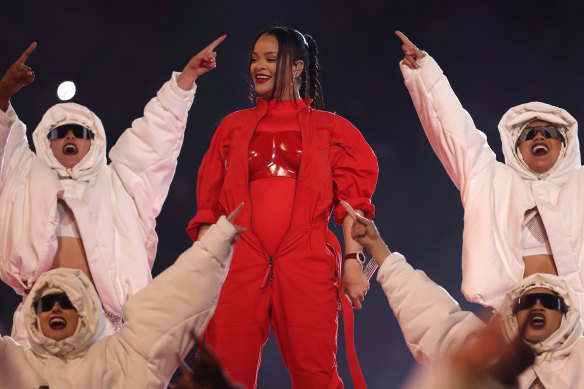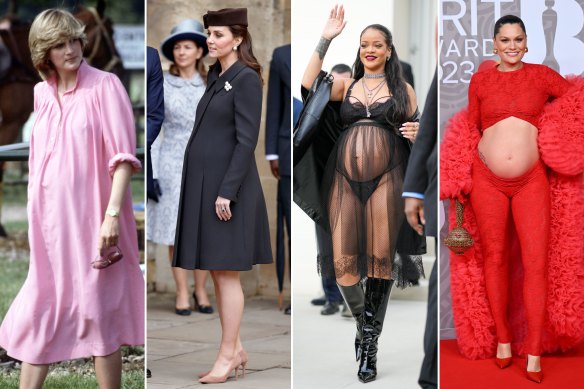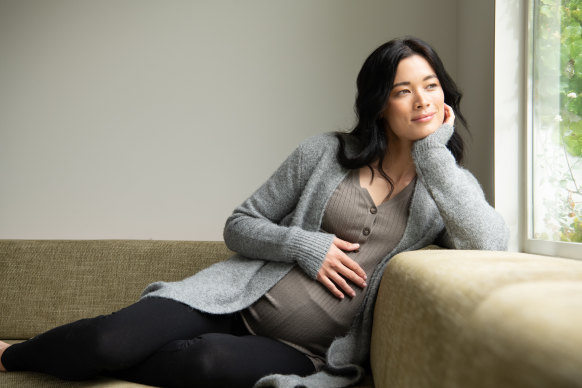When it comes to job interviews, the saying has always been “dress for the job you want, not the job you have.” But for decades, women “auditioning” for motherhood have had to cop an approach to maternity style that has often left fashion at the front gate.
Remember Princess Diana’s tent-like dresses when she was expecting princes William and Harry? Sure, it was the 1980s, an era also marked by women in the workplace being expected to do everything in their power to make their (male) bosses forget they were pregnant, lest they be written off as incompetent or transient.

Rihanna has broken the ‘rules’ of maternity dressing in both her pregnancies. Credit: Getty
Thankfully, times have changed, and pregnant women can now rock bodycon with abandon. But thanks to celebrities – including Diana’s successor as Princess of Wales, Catherine, and the newly ordained patron saint of pregnancy dressing, Rihanna – the very definition of “maternity wear” is getting a royal shake-up.
Writer and content editor for Mecca, Zara Wong, appealed to pregnant and postpartum women everywhere when she penned an edition of her “Screenshot this” newsletter last October with the heading, “I never bought maternity clothes. Here’s what I wore when pregnant.” Her list included black leggings, striped knits and elasticised dress pants – and not a single recommendation for a maternity brand.
Although Wong, who formerly worked at Vogue Australia, wouldn’t declare herself “anti-maternity wear”, she says the industry needs to stop selling short-term solutions to women, due to sustainability concerns. She also thinks a lot of maternity gear leaves style-conscious women feeling cold. “The nature of maternity wear is that they have to be [less] seasonally led. Because of that, they can seem a bit plain or less interesting,” she says.

From left: Princess Diana, Catherine, Princess of Wales, Rihanna and Jessie J.Credit: Getty
During my own pregnancy in 2021, which was mainly spent in lockdown on a diet of leggings and jeggings, I discovered Facebook forums devoted to pregnancy fashion hacks by women desperate to avoid “traditional” maternity gear. I learnt which Lululemon leggings were most bump-friendly, and the cult Decjuba jeans that, while not specifically maternity, were easy to get on and off when I could no longer see my feet.
Wong thinks mainstream fashion retailers are missing an opportunity to highlight styles that are “bump friendly” that can also be worn long afterwards. “You have to be quite creative to seek it out. If some luxury brand retailers had that section, they would do quite well,” she says.
Phoebe Simmonds, co-founder of parenting site The Memo, says celebrities such as Rihanna and Jessie J, who bared her belly at the Brit awards on Sunday, are shifting perceptions of maternity style, and pregnancy more generally. “It’s so indicative of the mood of women in 2023. You can see [Rihanna] has so much fun being pregnant,” says Simmonds.
And the “Rihanna effect” is spreading to Australia, if last weekend’s baby shower for Married at First Sight alumna Martha K, who wore a belly-baring Effie Kats ensemble, is any guide. But not every pregnant woman is comfortable with that level of fashion forwardness, says Lisa Balakas, creative director and co-founder of Ripe Maternity.

Ripe Maternity is still focused on a more ‘traditional’ customer.
“One of the criticisms maternity wear cops is that often people [with a strong interest in fashion] want a quirky look or more of an expensive price point. But as a brand, we need to look at the majority of the community. There aren’t a lot of Rihannas around,” she says.
Still, fashion trends are always top of mind. Balakas says a recent design challenge was making wider-leg maternity jeans that looked as good as their straight or skinny counterparts. And, also, extending the longevity of each garment beyond the postpartum period.
“We understand our customer at that time is looking at what they’re spending their money on … we’re aware of those [financial] constraints,” she says.
Simmonds says most women still want at least one “wow” fashion moment in their pregnancy, even if baring their belly isn’t their jam. For her, it was a jumpsuit that made her “feel like Catwoman” that she still wears now her son, Remy, is nine months old.
“I would never have worn that in my 20s or early 30s – when I became pregnant I felt I was going to really embrace this body.”
Make the most of your health, relationships, fitness and nutrition with our Live Well newsletter. Get it in your inbox every Monday.